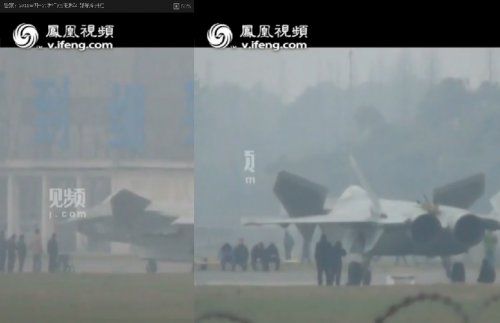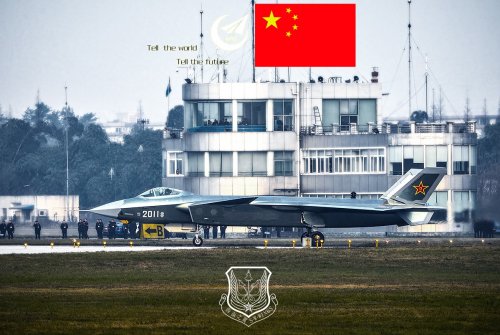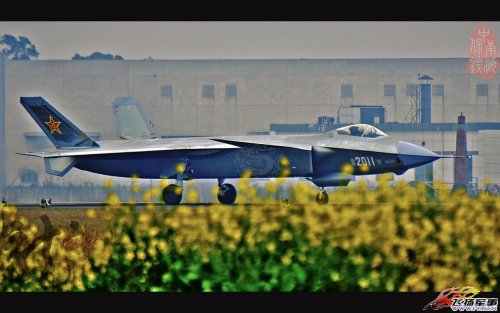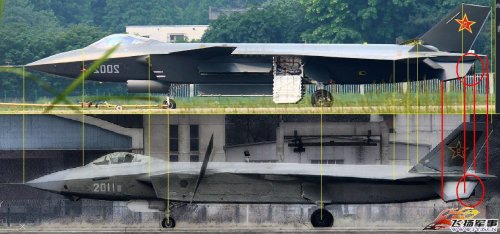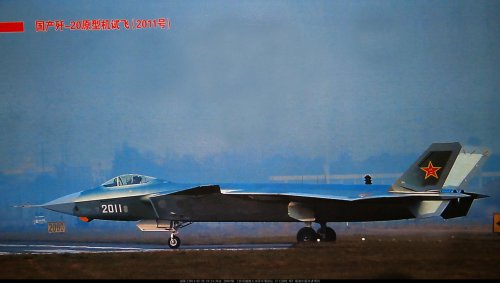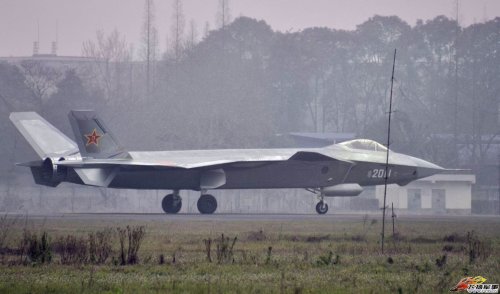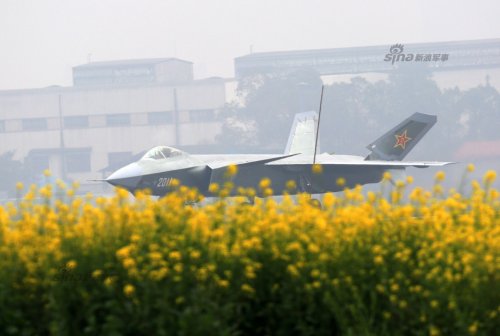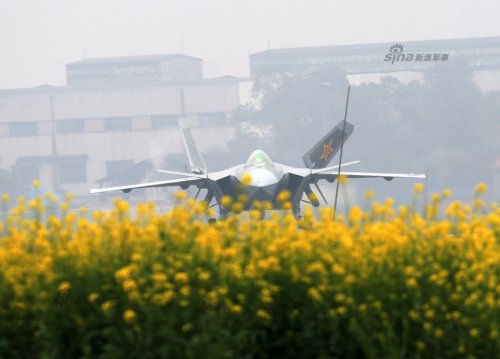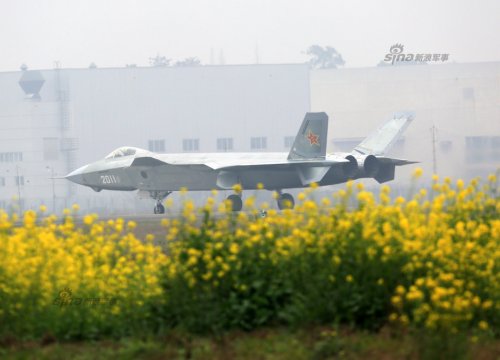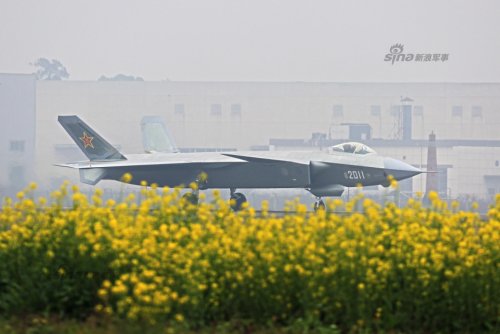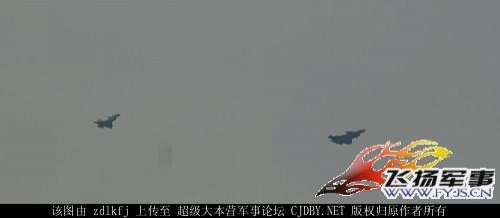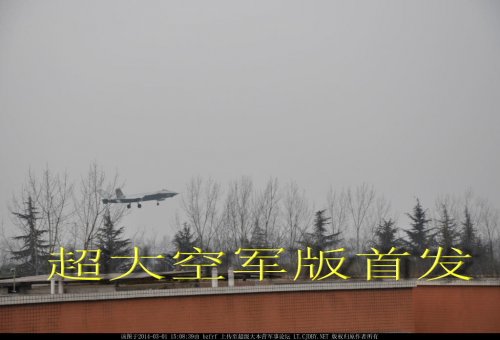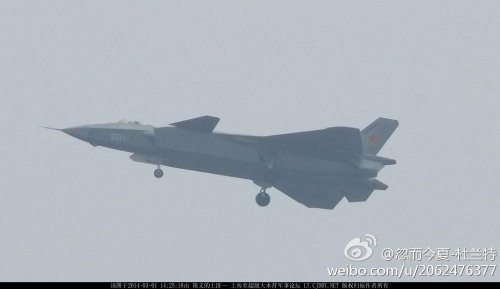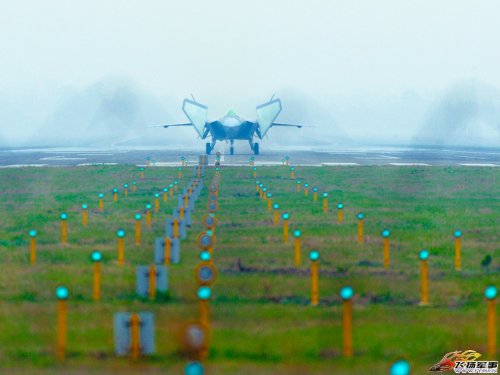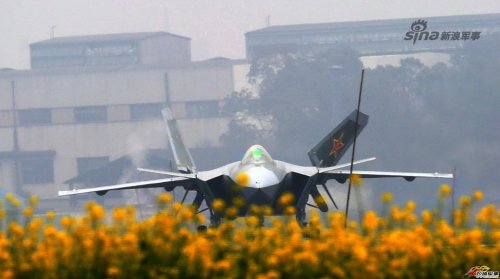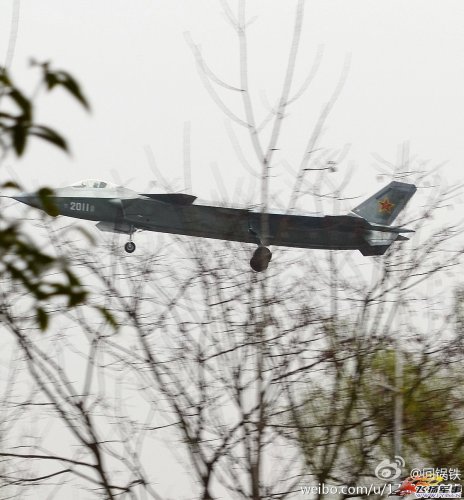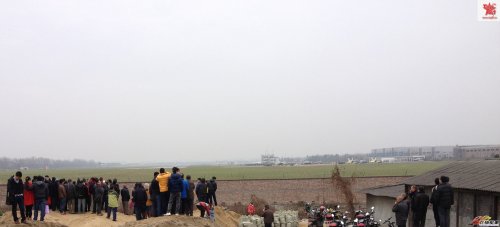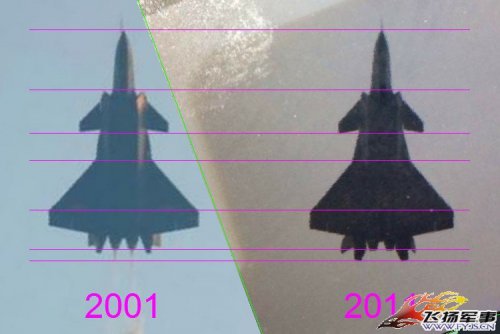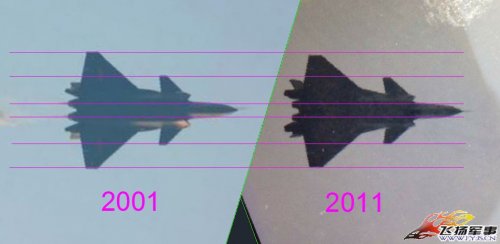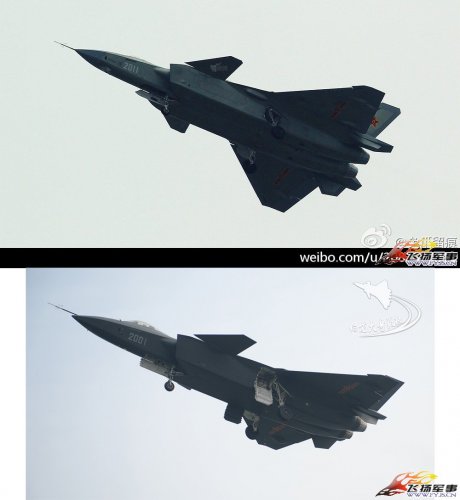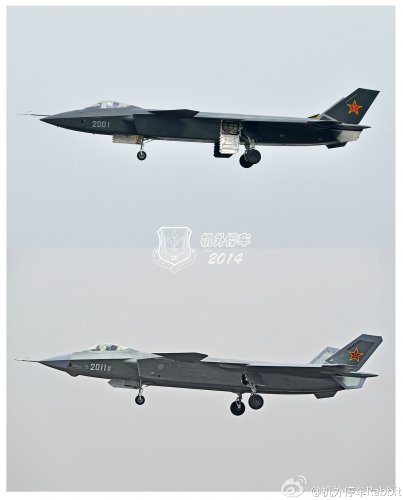You are using an out of date browser. It may not display this or other websites correctly.
You should upgrade or use an alternative browser.
You should upgrade or use an alternative browser.
Chengdu J-20 pictures, analysis and speculation Part II
- Thread starter overscan (PaulMM)
- Start date
latenlazy
I really should change my personal text
- Joined
- 4 July 2011
- Messages
- 245
- Reaction score
- 37
latenlazy said:Oops. Accidentally quoted myself instead of editing.
- Joined
- 2 January 2006
- Messages
- 3,829
- Reaction score
- 5,143
JFC Fuller said:latenlazy said:Here's one without the perspective problem. Judge for yourself.
Yup, still looks big. Thanks for proving my point. :
Yupp ... but that was never under discussion ! It was always clear that the J-20 is a "big" fighter ... but still smaller/ not as wide as a Flanker !
So what's Your point ??
Deino
- Joined
- 22 April 2012
- Messages
- 2,259
- Reaction score
- 2,319
Deino said:Yupp ... but that was never under discussion ! It was always clear that the J-20 is a "big" fighter ... but still smaller/ not as wide as a Flanker !
So what's Your point ??
Deino
That it's big and thus looks big in photos, and we don't need an in depth analysis to demonstrate what we already know. But latenlazy felt like wasting a few posts so here we are.
latenlazy
I really should change my personal text
- Joined
- 4 July 2011
- Messages
- 245
- Reaction score
- 37
JFC Fuller said:Deino said:Yupp ... but that was never under discussion ! It was always clear that the J-20 is a "big" fighter ... but still smaller/ not as wide as a Flanker !
So what's Your point ??
Deino
That it's big and thus looks big in photos, and we don't need an in depth analysis to demonstrate what we already know. But latenlazy felt like wasting a few posts so here we are.
Waste not want not, you and me both.
JFC Fuller said:Deino said:Yupp ... but that was never under discussion ! It was always clear that the J-20 is a "big" fighter ... but still smaller/ not as wide as a Flanker !
So what's Your point ??
Deino
That it's big and thus looks big in photos, and we don't need an in depth analysis to demonstrate what we already know. But latenlazy felt like wasting a few posts so here we are.
I'm not sure if you're aware, but the topic of J-20's size has become a somewhat touchy issue over the years for many, so even if you didn't know that and said J-20 was big in an off hand way, you could at least appreciate that Latenlazy's effort to elucidate on just how big it is.
Hey, at the very least you now have an objective comprehension of J-20's dimensions, something to refer back to...
donnage99
ACCESS: Top Secret
- Joined
- 16 June 2008
- Messages
- 1,359
- Reaction score
- 883
JFC Fuller said:That it's big and thus looks big in photos, and we don't need an in depth analysis to demonstrate what we already know. But latenlazy felt like wasting a few posts so here we are.
Seems like someone dug a hole for himself and is trying to get out.
- Joined
- 2 January 2006
- Messages
- 3,829
- Reaction score
- 5,143
Sorry to step in, but these are exactly these stupid postings from - "honestly to say so - either stupid members or some, who simply want to troll around.
As such with so stupid posts like assuming some members might be "oversensitive" or "unable to understand an argument" ... or so I can really understand that some are getting angry, since strangely the only ones, who simply don not want to accept the facts or simply still want to stick to their own believes are the reason for such - in fact stupid - discussions.
I really can't understand why some still pretend to prefer to their eyeball estimations like "by the look at it in comparison relative to ..." even if we have hard facts by an - admitted slightly blurred - image which shows all three aircrafts in question side by side with the being J-15 substantially larger (= longer and wider) than the J-20 ??? ?
But since You are not that way, You can surely explain me how on earth could the J-20 be larger than a Flanker ??? ... even if this would contradict the wishfull-thinking of "it has to be larger than" of a few ??
Deino
As such with so stupid posts like assuming some members might be "oversensitive" or "unable to understand an argument" ... or so I can really understand that some are getting angry, since strangely the only ones, who simply don not want to accept the facts or simply still want to stick to their own believes are the reason for such - in fact stupid - discussions.
I really can't understand why some still pretend to prefer to their eyeball estimations like "by the look at it in comparison relative to ..." even if we have hard facts by an - admitted slightly blurred - image which shows all three aircrafts in question side by side with the being J-15 substantially larger (= longer and wider) than the J-20 ??? ?
But since You are not that way, You can surely explain me how on earth could the J-20 be larger than a Flanker ??? ... even if this would contradict the wishfull-thinking of "it has to be larger than" of a few ??
Deino
- Joined
- 2 January 2006
- Messages
- 3,829
- Reaction score
- 5,143
I know, but since You were taking part on this discussion You can probably explain me why some still predend to say so simply since this is the reason why this "question" is so controversially discussed and some are maybe even a bit "over-sensitive" !
Anyway back to the J-20 ... here's a new video and it seems as if also the canards were cut in the corners similar to the tails.
http://v.ifeng.com/mil/mainland/2014002/0142c6cb-82ab-4bd7-b0bd-ba92832f90a7.shtml
Anyway back to the J-20 ... here's a new video and it seems as if also the canards were cut in the corners similar to the tails.
http://v.ifeng.com/mil/mainland/2014002/0142c6cb-82ab-4bd7-b0bd-ba92832f90a7.shtml
Attachments
FighterJock
ACCESS: Above Top Secret
- Joined
- 29 October 2007
- Messages
- 5,614
- Reaction score
- 5,947
Deino said:That made my day... and now just let this dragon fly !!

Deino
Hope it does soon, the tension is killing me.
R
Radical
Guest
More J-20 pictures from SDF.




- Joined
- 3 June 2011
- Messages
- 18,356
- Reaction score
- 12,286
flateric said:it's just my illusion or vertical tails chord somewhat reduced, too?
If you look at the base they are turned a bit.
R
Radical
Guest
donnage99 said:So it seems that the ventral fins are there to stay? It may helps with IR reduction but I don't know about RCS especially from below
There will be sacrifices. Exactly how much is hard to say, gotta actually test it.
latenlazy
I really should change my personal text
- Joined
- 4 July 2011
- Messages
- 245
- Reaction score
- 37
donnage99 said:So it seems that the ventral fins are there to stay? It may helps with IR reduction but I don't know about RCS especially from below
I kind of liken it to the F-22's inlet diverters. I also think of it as a trade off or break even for having smaller all moving tails. That yaw stability has to come somewhere. The F-22 has giant vertical tails for that exact purpose. On this front the PAK-FA is probably better than the F-22 and J-20 (I think they get their yaw stability from TVC and by controlling vortices with their LEVCON). Can't have everything.
donnage99
ACCESS: Top Secret
- Joined
- 16 June 2008
- Messages
- 1,359
- Reaction score
- 883
latenlazy said:I kind of liken it to the F-22's inlet diverters. I also think of it as a trade off or break even for having smaller all moving tails. That yaw stability has to come somewhere. The F-22 has giant vertical tails for that exact purpose. On this front the PAK-FA is probably better than the F-22 and J-20 (I think they get their yaw stability from TVC and by controlling vortices with their LEVCON). Can't have everything.
The smaller all moving vertical tails may have been for reducing drag and not for RCS. Large or small surfaces don't really matter in term of RCS as much as the how angled these surfaces are. In fact, I think all moving vertical tails may hurt RCS since the breaks between control surfaces are exposed from frontal view.
latenlazy
I really should change my personal text
- Joined
- 4 July 2011
- Messages
- 245
- Reaction score
- 37
donnage99 said:latenlazy said:I kind of liken it to the F-22's inlet diverters. I also think of it as a trade off or break even for having smaller all moving tails. That yaw stability has to come somewhere. The F-22 has giant vertical tails for that exact purpose. On this front the PAK-FA is probably better than the F-22 and J-20 (I think they get their yaw stability from TVC and by controlling vortices with their LEVCON). Can't have everything.
The smaller all moving vertical tails may have been for reducing drag and not for RCS. Large or small surfaces don't really matter in term of RCS as much as the how angled these surfaces are. In fact, I think all moving vertical tails may hurt RCS since the breaks between control surfaces are exposed from frontal view.
You're probably right about the tails primarily addressing drag, now that I think about it, but keep in mind that having stationary horizontal tails probably has the same impact as having those ventral fins, except perhaps the extra corner reflector.
I do think that you might need less deflection to achieve the same amount of side force with all moving tails, which might minimize the RCS impact, expose less surface back at the beam source. Although, we should also keep in mind that if the plane is deflecting its tails, unless it's braking it's probably turning, so then side aspect rcs might come into play, in which case it might be better to have smaller all moving tails than larger static ones? There's a reason why this is an experimental science and not a theoretical one! But I feel like I've made my point, mostly, about no design being perfect, and that was the more important bit I was trying to impart, I think.
- Joined
- 27 December 2005
- Messages
- 17,759
- Reaction score
- 26,514
- Joined
- 3 June 2011
- Messages
- 18,356
- Reaction score
- 12,286
I wonder if it helps with reducing vortex generation too (and if those can be seen on radar themselves). ???PaulMM (Overscan) said:This image appears to be from a Chinese academic paper showing the reduction in RCS achieved from cutting off the corner of a canard. Allegedly, 3GHz, S-Band. (watermark obscures the legend).
Kryptid
ACCESS: Secret
- Joined
- 12 March 2009
- Messages
- 282
- Reaction score
- 52
Interesting. Seems almost counter-intuitive to me (I had previously come to believe that fewer edges = better RCS).PaulMM (Overscan) said:This image appears to be from a Chinese academic paper showing the reduction in RCS achieved from cutting off the corner of a canard. Allegedly, 3GHz, S-Band. (watermark obscures the legend).
- Joined
- 6 August 2007
- Messages
- 3,902
- Reaction score
- 6,025
Kryptid said:Interesting. Seems almost counter-intuitive to me (I had previously come to believe that fewer edges = better RCS).
Yes, that is not true at all.
latenlazy said:donnage99 said:latenlazy said:I kind of liken it to the F-22's inlet diverters. I also think of it as a trade off or break even for having smaller all moving tails. That yaw stability has to come somewhere. The F-22 has giant vertical tails for that exact purpose. On this front the PAK-FA is probably better than the F-22 and J-20 (I think they get their yaw stability from TVC and by controlling vortices with their LEVCON). Can't have everything.
The smaller all moving vertical tails may have been for reducing drag and not for RCS. Large or small surfaces don't really matter in term of RCS as much as the how angled these surfaces are. In fact, I think all moving vertical tails may hurt RCS since the breaks between control surfaces are exposed from frontal view.
You're probably right about the tails primarily addressing drag, now that I think about it, but keep in mind that having stationary horizontal tails probably has the same impact as having those ventral fins, except perhaps the extra corner reflector.
I do think that you might need less deflection to achieve the same amount of side force with all moving tails, which might minimize the RCS impact, expose less surface back at the beam source. Although, we should also keep in mind that if the plane is deflecting its tails, unless it's braking it's probably turning, so then side aspect rcs might come into play, in which case it might be better to have smaller all moving tails than larger static ones? There's a reason why this is an experimental science and not a theoretical one! But I feel like I've made my point, mostly, about no design being perfect, and that was the more important bit I was trying to impart, I think.
Actually thanks to the ventral strakes, the total vertical stabilizer surface on the J-20 is probably not that much smaller than on other contemporary fighters (and hence the drag advantage fairly moderate). Re-distributing some of that area below the roll axis should help reduce some roll/yaw coupling effects, rather than just relying on the flight control system to deal with them as the Typhoon and F-22 do. The T-50 must have been a pain to get right in this regard - which makes it all the more impressive how quickly and confidently they expanded its flight envelope. Sukhoi certainly seems to have the flight control aspect of fighter design nailed right down!
latenlazy
I really should change my personal text
- Joined
- 4 July 2011
- Messages
- 245
- Reaction score
- 37
Maybe not. My understanding of the reason they went with canards (and the dihedral arrangement) is in part to generate vortices for lift at high alpha.sferrin said:I wonder if it helps with reducing vortex generation too (and if those can be seen on radar themselves). ???PaulMM (Overscan) said:This image appears to be from a Chinese academic paper showing the reduction in RCS achieved from cutting off the corner of a canard. Allegedly, 3GHz, S-Band. (watermark obscures the legend).
- Joined
- 2 January 2006
- Messages
- 3,829
- Reaction score
- 5,143
- Joined
- 2 January 2006
- Messages
- 3,829
- Reaction score
- 5,143
- Joined
- 21 April 2009
- Messages
- 13,768
- Reaction score
- 7,716
sferrin said:That is one good-looking plane.
Agree but does anyone else get a chill seeing the prominent 'Red Star'. Feels like Cold War Redux.
bobbymike said:sferrin said:That is one good-looking plane.
Agree but does anyone else get a chill seeing the prominent 'Red Star'. Feels like Cold War Redux.
I think it would look better, more modern if the roundels were shades of grey instead, like how USAF brands their fighters.
- Joined
- 27 December 2005
- Messages
- 17,759
- Reaction score
- 26,514
Removed off topic posts.
- Joined
- 2 August 2006
- Messages
- 3,256
- Reaction score
- 1,529
bobbymike said:Agree but does anyone else get a chill seeing the prominent 'Red Star'. Feels like Cold War Redux.
Not really. When the cold war was going on the Soviet Union wasn't a favored nation trading partner and building all kinds of product for us. They also weren't letting average people talk to their people, much less higher ups. I talk to our Chinese suppliers all the time and our people go there and their's come here quite often.
What's going on over in China militarily right now seems more like "teenage super-power preening," more than anything else to me. Also, it was the Western economy that won the cold war, not the military itself. As such, with the U.S. and Chinese economy so intertwined, whatever happens will be very little like the Cold War era.
Though I must admit, their Red Star does look similar to the Soviet Union's Red Star.
Having said that, the J-20 is a nice looking airplane.
- Joined
- 2 January 2006
- Messages
- 3,829
- Reaction score
- 5,143
- Joined
- 27 December 2005
- Messages
- 17,759
- Reaction score
- 26,514
- Joined
- 2 January 2006
- Messages
- 3,829
- Reaction score
- 5,143
They are getting better ... these tail sponssons seem to be different !
Attachments
-
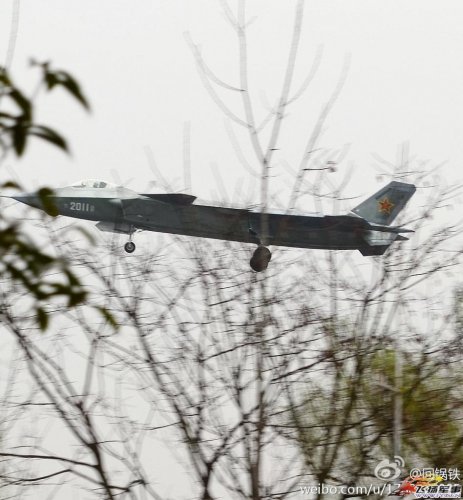 J-20 2011 - maiden flight 1.2.14 - 15.jpg121.6 KB · Views: 50
J-20 2011 - maiden flight 1.2.14 - 15.jpg121.6 KB · Views: 50 -
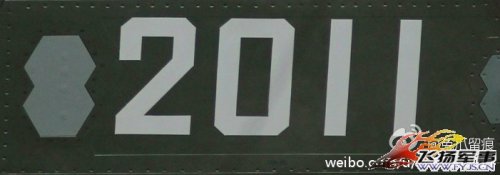 J-20 2011 - maiden flight 1.2.14 - 14.jpg28.5 KB · Views: 66
J-20 2011 - maiden flight 1.2.14 - 14.jpg28.5 KB · Views: 66 -
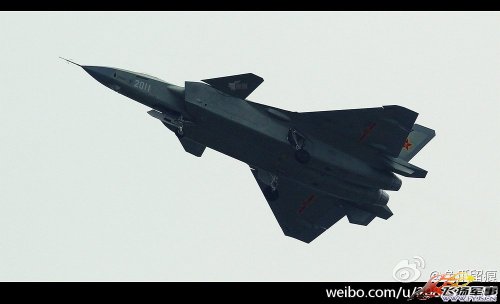 J-20 2011 - maiden flight 1.2.14 - 13.jpg62.5 KB · Views: 83
J-20 2011 - maiden flight 1.2.14 - 13.jpg62.5 KB · Views: 83 -
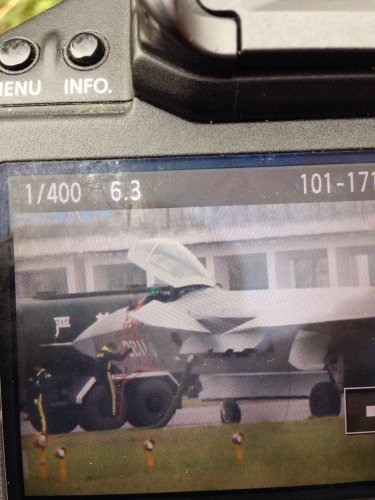 J-20 2011 - maiden flight 1.2.14 - 12.jpg189.6 KB · Views: 59
J-20 2011 - maiden flight 1.2.14 - 12.jpg189.6 KB · Views: 59 -
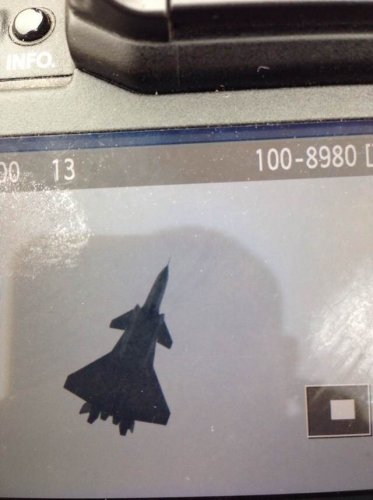 J-20 2011 - maiden flight 1.2.14 - 11.jpg67 KB · Views: 56
J-20 2011 - maiden flight 1.2.14 - 11.jpg67 KB · Views: 56
- Joined
- 27 December 2005
- Messages
- 17,759
- Reaction score
- 26,514
latenlazy
I really should change my personal text
- Joined
- 4 July 2011
- Messages
- 245
- Reaction score
- 37
PaulMM (Overscan) said:And LERX appears to be straightened. Just a couple of spotters hanging about
[very slightly higher res]
The LERXes in front of the canards seem to be gone. I kinda miss them. Clearly the adjustments to the J-20's aerodynamics weren't exactly tiny (or those tiny LERXes just didn't matter that much).
- Joined
- 2 January 2006
- Messages
- 3,829
- Reaction score
- 5,143
latenlazy said:The LERXes in front of the canards seem to be gone. I kinda miss them. Clearly the adjustments to the J-20's aerodynamics weren't exactly tiny (or those tiny LERXes just didn't matter that much).
Yes, the changes are more significant than I expected at first !
+ the best image so far !!!
Attachments
Similar threads
-
-
-
-
Shenyang FC-31 demonstrators / J-35 naval fighter / J-35A land-based version
- Started by Foxglove
- Replies: 1K
-
Photos and analysis of China's J-20 fighter as it nears first flight
- Started by Foxglove
- Replies: 522

